There are two types of disc brake calipers – floating and fixed! We discuss the pros and cons of both of them in this informative story…
Brake caliper is one of the most important part of the Disc Brake Assembly. A Caliper assembly contains various fixed and moving parts. It is like your engine where you have piston, cylinder and other moving parts.
Before we move onto this story, we have already published the first part. Have you read it? If not here is the direct link
Types of Disk Brakes – Advantages & Disadvantages (Part 1)
Parts of Caliper
A Caliper assembly contains Adapter, Cylinder bore, piston, piston seal, Dust boot etc. Here is a pictorial view of the parts of a caliper.
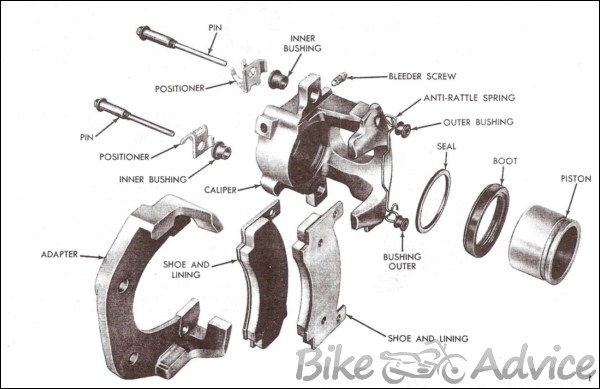
Adapter: It is also known as supporter or hanger. It is a fixed support to the caliper assembly. It is bolted to steering knuckle and takes the entire braking load.
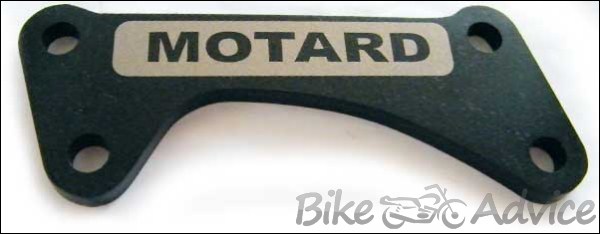
Caliper: It is that part of the caliper assembly which provides housing to hydraulic pistons. Generally, it is made of three kinds of materials – cast iron, magnesium and aluminum as we have seen in type of cylinders. Depending on the requirement the material of caliper can be change.
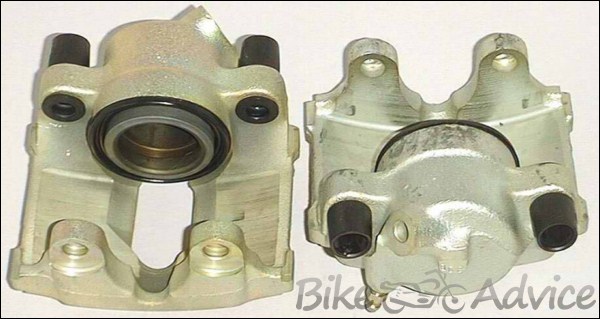
Cylinder bore: It is that part of caliper in which the piston moves. The size and number of cylinder bore varies according to the size and number of pistons used.
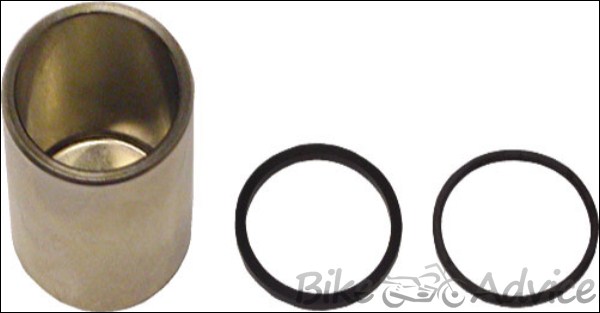
Piston: A piston pushes brake pads towards the brake disc/rotor. The piston size varies according to the braking force needed. Similarly the number of pistons also varies depending on the type of caliper used. The braking force of one large piston is roughly equal to the braking force of two small pistons.
Piston Seal: A piston seal, also known as piston ring, keeps the brake fluid behind the piston and brake pads.
Dust boot: A dust boot, also known as piston boot, is placed to prevent dust and dirt going inside the cylinder bore.
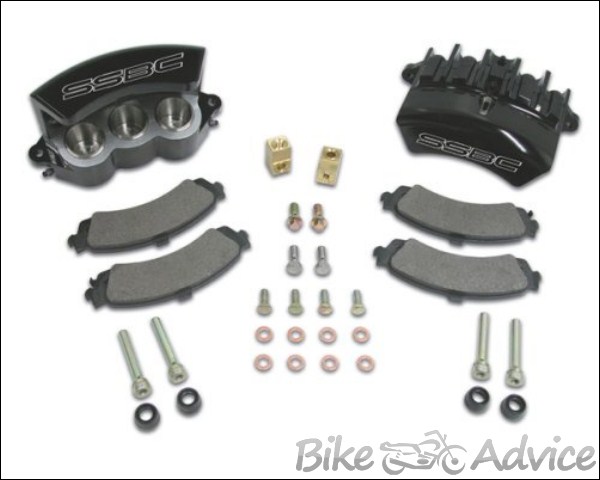
Pins and Bushes: The caliper is mounted on pins and Bushes. In floating caliper it helps the caliper to move from side to side.
Positioner: The positioner is placed between pins and bushes. It holds the caliper outward when the lever or pedal is released so that the outward brake shoe can move away from the disc. It also acts as a wear indicator for brake pads. It bends and close up when brake pads worn out.
Retraction Spring: it is also known as anti-rattle spring. It does the same function what return springs do in drum brakes. It keeps the brake pad in contact with piston and caliper fingers.
Brake Pad
Brake pad plays the same role as brake liner plays in drum brakes. Generally two brake pads require per brake disc/rotor. It is a wear and tear part of caliper assembly. It is made of small pieces of high friction material. The type of friction material varies as per the requirement of vehicle.
Materials which make up the brake pads include friction modifiers, powdered metal, binders and fillers. Friction modifiers such as graphite and cashew nut shells are used to alter friction coefficient. Powdered materials such as lead, zinc and brass etc increase a material’s resistance to heat fade.
Fillers are added to friction material in small quantities to accomplish specific tasks, such as rubber chips to reduce brake noise. You need to check the brake pad if it is due for replacement. Generally brake pad comes with wear indicator which is a small groove between the brake pad. When this small groove is not visible, you need to replace the brake pad. It should always be replaced in pair even if only one pad is worn out.

Let’s see how caliper assembly works when brake lever is pressed or released
When brake lever or the pedal is pressed, the brake fluid creates hydraulic pressure inside the cylinder bore of the caliper. This pressure forces piston to move towards brake pads inside the caliper. The piston ring moves in rolling shape with the piston.
This movement causes brake pads to stick to the brake disc which creates friction and stops the brake disc/rotor to rotate. When the brake lever or pedal is released, the piston ring pushes the piston back to the cylinder bore of the caliper till both the piston and piston ring come to their original positions.
Types of Disc Brake Calipers
There are two types of brake calipers – Floating Caliper and Fixed Caliper
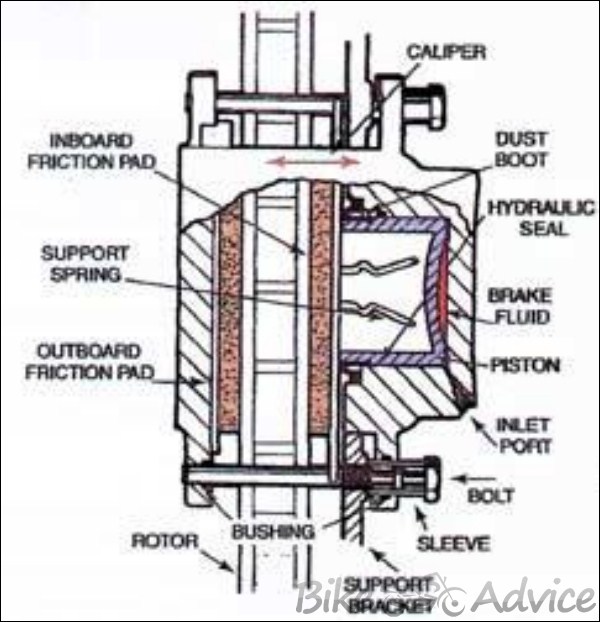
Floating Caliper:
It is also known as sliding caliper. As the name suggests a floating caliper moves in a path within its support with respect to the movement of brake disc/rotor. The floating caliper has a piston on only one side. On the other side it only has brake pad. So the floating caliper always has a combination of one piston two brake pads. The location of piston is just behind the inner brake pad.
It works on the Newton’s third low of motion – “To every action there is always an equal and opposite reaction”. When a brake lever is pressed, hydraulic pressure forces piston towards the inner brake pad which in turns pushes the inner brake pad towards the brake disc/rotor.
At this moment the reaction force pushes caliper body towards the outer brake pad. In this way the caliper creates friction from both the sides on the brake disc/rotor. The other noticeable difference in floating caliper is that the brake fluid directly goes in to the caliper via hydraulic passage inside the caliper. Floating caliper can use 1, 2 or 3 pistons.
INFORMATIVE: How Motorcycle Tyres Are Manufactured?
Floating Caliper Advantages
- It requires less parts compared to fixed caliper.
- It is less expensive to manufacture.
- It is widely used.
- It is easier to bleed floating caliper compared to fixed caliper.
- It is generally made of cast iron or steel which in turn increases weight and heat compared to the aluminum fixed caliper. A heavy weight stops the disc faster than light weight.
- The other advantage is that the floating caliper can better dissipate heat due to sliding nature and therefore less chances of brake fade.
Long Stroke and Short Stroke Engines – Explained in Simple Terms
Floating Caliper Disadvantages
- It require more pressure for clamping the disc than fixed caliper piston
- Some loss of brake torque due to sliding of rotor.
- It requires higher amount of brake fluid due to the diameter of piston.
- It has lesser life and durability compared to fixed piston caliper.
- It is lesser stiffer than fixed caliper.
- It can boil up the brake fluid in case of overheating of the disc.
- It has problem of sticking due to dirt and corrosion.
Fixed Caliper:

Informative: How Drum Brake Works? Explained with Pics
As the name suggests a fixed caliper does not move with the rotation of the brake disc/rotor. The fixed caliper requires a fixed mounting adapter. It is rigidly mounted to the steering knuckle. The fixed caliper has pistons on both the side. So it, generally, has combination of two pistons and two brake pads. When the brake lever is pressed, hydraulic pressure pushes both the pistons which in turn pushes both the brake pads towards the brake disc.
Ultimately, the brake pads stick to the brake disc/rotor and create friction which stops the brake disc/rotor from moving. The fixed caliper mechanism creates equal pressure from each side. In fixed caliper the brake fluid is routed through crossover lines or steel tubing which is placed outside the caliper housing. They are directed in to caliper halves with sealed O-rings. A fixed caliper may have 2, 4, 6 or 8 pistons depending on the requirement of the vehicle. There are three piston fixed calipers also there which have two small pistons on the one side and one big piston on the other side.
What Is Engine Knocking? How To Avoid it in Your Bike?
Fixed Caliper Advantages
- It generates higher braking torque than the floating caliper
- There is no loss of braking torque due to sliding as fixed caliper does not move.
- It is generally made of aluminum which means it has better heat dissipation as compared to cast iron or steel caliper
- It does not have the problem of sticking as it is made of aluminum which is less prone to rust and corrosion.
- It is stiffer than floating caliper.
- It has better life and durability as compared to floating caliper.
Fixed Caliper Disadvantages
- It is expensive to manufacture
- It has more complex structure and requires more moving parts compared to floating caliper
- The use of fixed caliper is limited to luxury and high performance vehicles.
- Fixed caliper requires more effort to bleed than floating caliper.
Tyre Ratings, Maintenance: All You Must Know About Tyres – in Simple Terms
– Mahavir Kothari
Next read: “Which Engine Oil Shall I Use?” – Engine Oil Explained in Very Simple Terms
Images source: Wwnboa and Google images


